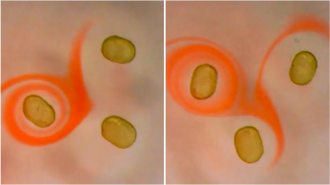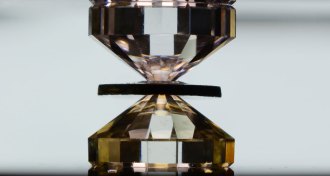Physics
Sign up for our newsletter
We summarize the week's scientific breakthroughs every Thursday.
-
 Materials Science
Materials SciencePermanent liquid magnets have now been created in the lab
Magnets that generate persistent magnetic fields are usually solid. But new little bar magnets have the mechanical properties of liquids.
-
 Cosmology
CosmologyScientists still can’t agree on the universe’s expansion rate
A mismatch in measurements of how fast the universe is expanding might not be real, a study hints.
-
 Materials Science
Materials ScienceLatest claim of turning hydrogen into a metal may be the most solid yet
If true, the study would complete a decades-long quest to find the elusive material. But such claims have been made prematurely many times before.
-
 Astronomy
AstronomyThe highest-energy photons ever seen hail from the Crab Nebula
An experiment in Tibet spotted photons with over 100 trillion electron volts of energy.
-
 Materials Science
Materials Science50 years ago, bulletproof armor was getting light enough to wear
In 1969, bulletproof armor used boron carbide fibers. Fifty years later, bulletproof armor is drastically lighter and made from myriad materials.
-
 Chemistry
ChemistryHow seafood shells could help solve the plastic waste problem
Chitin and chitosan from crustacean shells could put a dent in the world’s plastic waste problem.
By Carmen Drahl -
 Physics
PhysicsA computer model explains how to make perfectly smooth crepes
Here’s how to prepare thin pancakes that are perfectly smooth, according to science.
-
 Particle Physics
Particle PhysicsDiamond detectors could aid the search for dark matter
Elusive dark matter particles could be spotted when they slam into electrons or atomic nuclei within diamond, scientists say.
-
 Astronomy
AstronomyReaders boggled by black hole behemoth
Readers had questions about the first image of a black hole and a chytrid fungus.
-
 Particle Physics
Particle PhysicsPhysicists have finally figured out how pentaquarks are built
The particles are made of up two smaller particles, stuck together like atoms in a molecule.
-
 Physics
PhysicsThis tabletop device turns the quantum definition of a kilogram into a real mass
The mini Kibble balance will measure 10 grams to an accuracy of a few ten-thousandths of a percent.
-
 Physics
PhysicsIn a first, scientists took the temperature of a sonic black hole
A lab-made black hole that traps sound, not light, emits radiation at a certain temperature, as Stephen Hawking first predicted.